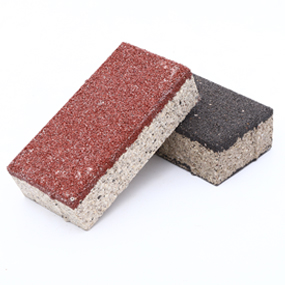Eight functions of ecological ceramics
1.good water permebility Natural precipitation can rapidly penetrate the surface of the earth, thus filling the groundwater resources in a timely manner, that is, storing water and reducing the phenomenon in the city.
2.Automatic adjustment function The excellent water permeability can adjust the temperature and humidity of the surface, eliminate the “heat island phenomenon” and maintain the ecological balance of the surface.
3.Safety and comfort There is no water on the road in rainy days to prevent reflection at night and improve the safety and comfort of vehicles and pedestrians.
4.Strong water absorption capacity It is used for public or family kitchens and bathroom floors. It can instantly absorb floating water and has excellent anti-slip effect.
5.Noise reduction capability The porous structure can absorb the noise generated by vehicles and create a quiet and comfortable traffic environment.
6.High compressive strength After being formed under high pressure and sintered at high temperature, its compressive and flexural strength are higher than those of other pavement materials.
7.Low carbon and environmental protection The product has a long service life and can be recycled indefinitely.
8.Eliminate haze At present, the haze phenomenon in northern cities is very serious. The main reason is that the air is dry, and the anti-floating particles cannot settle in time due to the lack of water vapor adsorption, and only the large surface auxiliary paste can eliminate the water breakthrough.
Product Parameter
|
item
|
unit
|
detection result
|
||
|
Splitting flexural strength
|
Mpa
|
average value:5.0,Single block minimum:4.2
|
||
|
Permeability coefficient
|
cm/s
|
2.2×10
|
||
|
freezing resistance
|
D25
|
Mass loss value of single block:2%,Depth of top surface defect after freezing:1mm,Strength loss:10%
|
||
|
Anti-skid value
|
BPN值
|
65
|
||
|
Abrasion resistance
|
mm
|
30
|
||
|
Compressive strength test
|
Mpa
|
40
|
||
History of permeable bricks
Replacing traditional materials with high-permeability materials has become a successful way to build an international metropolis Check. Permeable ground is used in cities to make natural precipitation directly penetrate into the ground and become groundwater This method was widely used in the ground laying of ancient cities and traditional courtyards in China. Therefore, in the 20th century Since the 1990s, it has become the consensus of the world’s urban construction to avoid laying impermeable hardened pavement as much as possible Practice. The laying of permeable ground is regarded as improving the environmental quality, reducing dry heat, preventing floods and reserving Water resources and important measures to prevent land subsidence are an important part of ecological city construction and urban sustainable development Important. For example, in Germany in the early 1980s, the production of permeable pavement materials has exceeded 45 million square meters, and it is reported that the application of ecological pavement is up to 20 million square meters. The construction volume of Japan reached 5 million square meters in 1988 and increased year by year, reaching 8.63 million square meters in 1996. Although affected by the economic recession, the construction volume of Japan still reached 7.19 million square meters in 1998. The use of sidewalks and squares accounted for more than 80% of the total in 1998, and the use of lanes accounted for 10%.
Regular Size

Regular Colors

Water Permeability
The ecological ceramic permeable brick of Snail Company has super water permeability function. Its water permeability exceeds 20 (mm/s), which is more than twice the standard of similar foreign products. It can easily cope with 60 millimeters of rainfall. It can be used to build roads and squares. Rainwater can quickly permeate and prevent urban flooding. Currently, land subsidence has occurred in many cities, mainly due to excessive loss of groundwater. The ground is sealed by cement and marble floors, resulting in rainwater not being able to penetrate the ground in a timely manner. However, snail ecological ceramic permeable bricks are used. Rain water can not only quickly penetrate the ground, restore its natural water storage capacity, prevent groundwater depletion, and improve the living environment of vegetation. It can also regulate atmospheric humidity, purify the air, eliminate smog, reduce ambient temperature, and restore the surface water circulation system, thus solving the “urban heat island effect” problem to a certain extent.
Water Retention

Installation Steps








 chinazisha@gmail.com
chinazisha@gmail.com 


